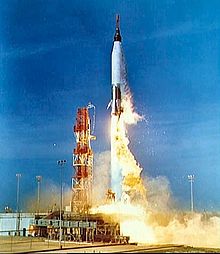- Mercury-Atlas 2
-
Mercury-Atlas 2 Mission insignia

Mission statistics Mission name Mercury-Atlas 2 Spacecraft mass 1,154 kilograms (2,540 lb) Crew size 0 Call sign MA-2 Launch date February 21, 1961
14:10 UTC
Cape Canaveral
LC-14Landing February 21, 1961
14:28 UTCMission duration 17 min 56 s Number of orbits suborbital Apogee 114 miles (183 km) Distance traveled 1,432 miles (2,305 km) Maximum velocity 13,227 miles per hour (21,287 km/h) Peak acceleration 156 m/s² (15.9 g) Related missions Previous mission Subsequent mission  MR-2
MR-2 Little Joe 5A
Little Joe 5AMercury-Atlas 2 (MA-2) was launched unmanned on February 21, 1961 at 14:10 UTC, from Launch Complex 14 at Cape Canaveral, Florida. Test objectives for this flight were concerned with the ability of the spacecraft to withstand reentry under the temperature-critical abort conditions and with the capability of the Atlas to meet the proper injection conditions. This Atlas "D" modified for the Mercury mission, was unique in the program in that it incorporated a stainless steel reinforcing band installed around the vehicle between stations 502 and 510. A thin sheet of asbestos was installed between the reinforcing band and the tank skin. This modification was installed as a precaution against the type of failure which had occurred on the previous MA-1 flight. MA-2 flew a successful suborbital mission that lasted 17 minutes 56 seconds. Altitude reached was 114 miles (183 km), speed, 13,227 mph (21,287 km/h). All test objectives were fully met. The capsule was recovered 1,432 miles (2305 km) downrange. Peak acceleration was 15.9 g (156 m/s²). Mass 1,154 kg.
Mercury spacecraft # 6 and Atlas # 67-D were used in the mission.
Mercury spacecraft # 6 used in the Mercury-Atlas 2 mission, is currently displayed at the Houston Museum of Natural Science, Houston, TX.[1]
References
See also
Project Mercury Missions Unmanned: Little Joe 1 · Big Joe 1 · Little Joe 6 · Little Joe 1A · Little Joe 2 · Little Joe 1B · Beach Abort · Mercury-Atlas 1 · Little Joe 5 · Mercury-Redstone 1 · Mercury-Redstone 1A · Mercury-Redstone 2 · Mercury-Atlas 2 · Little Joe 5A · Mercury-Redstone BD · Mercury-Atlas 3 · Little Joe 5B · Mercury-Atlas 4 · Mercury-Scout 1 · Mercury-Atlas 5
Manned: Mercury-Redstone 3 · Mercury-Redstone 4 · Mercury-Atlas 6 · Mercury-Atlas 7 · Mercury-Atlas 8 · Mercury-Atlas 9Subprograms Rockets See also: Mercury 13 · Mercury Seven · Navy Mark IV Categories: Mercury program | 1961 in spaceflight
Wikimedia Foundation. 2010.


